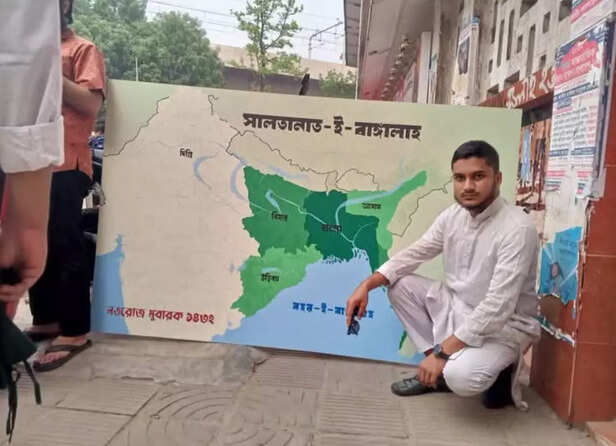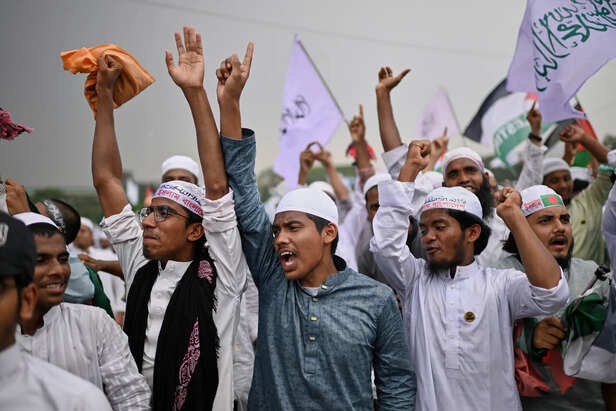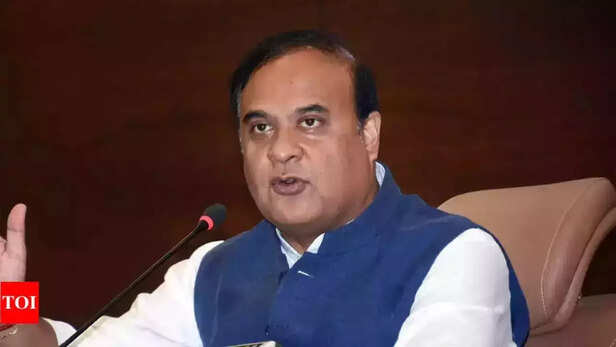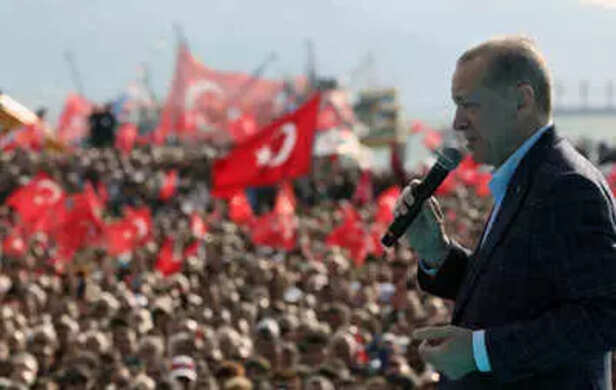PoK Hasn't Returned Yet—And Now the Fantasy of a 'Greater Bangladesh' Comes Forth
Ankit Gupta | Jun 04, 2025, 10:01 IST
A Turkish-backed Islamist group based in Dhaka, known as Saltanat-e-Bangla, recently circulated a controversial "Greater Bangladesh" map that includes parts of India's northeastern states such as Assam, West Bengal, and Tripura . This provocative act has heightened tensions between India and Bangladesh. In response, Assam Chief Minister Himanta Biswa Sarma issued a stern warning, emphasizing the strategic importance of the Siliguri Corridor—often referred to as the "Chicken's Neck"—which connects India's northeastern states to the rest of the country. He cautioned that any threats to this corridor would be met with decisive action .
A map has surfaced—blatant, provocative, and utterly delusional—circulated by a Turkey-backed Islamist group called Saltanat-e-Bangla, portraying a fantasy realm called "Greater Bangladesh." What makes this more than a cartographic hallucination is that the map claims significant Indian territory—Assam, West Bengal, Tripura—as its own. This is not just historical revisionism; it is geopolitical aggression draped in the robe of pan-Islamist ideology. India must not only protest but prepare, for this map signals more than ambition—it signals intent.

Maps are not harmless drawings. They are assertions of power, narratives of conquest, and psychological tools of intimidation. The so-called “Greater Bangladesh” map is exactly that: an ideological hand grenade hurled into the heart of India’s sovereignty. While the immediate source is an Islamist group in Dhaka, the fingerprints of Ankara are unmistakable. Turkey, under President Recep Tayyip Erdoğan, has been aggressively pushing a neo-Ottoman, pan-Islamic foreign policy, and this aligns with his agenda of exporting political Islam far beyond Turkish borders.
This map is no isolated meme—it is a soft launch of radical expansionist dreams. It attempts to redraw India’s northeast under a religious-nationalist framework, echoing the dangerous, historically violent concept of Ghazwa-e-Hind.

To understand this ideological provocation, one must look at the ground reality in Bangladesh. The resignation of Sheikh Hasina—long regarded as a stabilizing force and staunch anti-terrorism leader—created a dangerous vacuum. Her replacement, Nobel laureate Muhammad Yunus, may appear benign, but his interim regime has begun reversing years of anti-extremist progress. The lifting of bans on Islamist groups, the increasing tolerance of pro-Pakistan rhetoric, and now the silent nod to an imaginary “Greater Bangladesh” point to something far more dangerous than political miscalculation: ideological subversion.
What does this new alignment mean? A Bangladesh slowly drifting into the axis of Pakistan, Turkey, and Qatar—a trio that has often fanned Islamist extremism for geopolitical leverage. The "Greater Bangladesh" fantasy isn't merely about land. It’s about creating an ideological safe haven—a Darul Islam—in South Asia’s most volatile region.

It is tempting to dismiss such maps as internet pranks or fringe fantasies. That would be a fatal error. History is full of empires that began as hallucinations in the minds of fanatics. The Islamic State’s caliphate started with propaganda videos and fantasy maps. China’s nine-dash line was once considered absurd. Now it's military doctrine. If India doesn’t crush this narrative early, it risks legitimizing it by inaction.
The inclusion of Assam, West Bengal, and Tripura is not random. These states, especially Assam and West Bengal, have seen decades of unchecked illegal immigration from Bangladesh—an issue deliberately ignored by successive governments until recently. Entire districts have undergone demographic shifts. The Citizenship Amendment Act (CAA) was a response to this silent invasion, yet it was met with violent protests fueled partly by the same ideological networks that now circulate maps claiming the same territories.
Himanta Biswa Sarma, the bold Chief Minister of Assam, has rightly issued a fierce warning to Dhaka: “Keep your eyes off the Chicken’s Neck.” The Siliguri Corridor is more than a sliver of land—it is India’s spinal cord to its northeast. Any rhetoric that hints at its strategic destabilization is not freedom of speech—it is a precursor to geopolitical sabotage.

At the center of this entire episode stands Turkey. Under Erdoğan, Turkey has been weaponizing Islamic identity to build influence across Asia, Africa, and Europe. In the Balkans, in Somalia, in Libya, and now in South Asia, Turkey has funded madrasas, supported Islamist charities, and built cultural networks under the guise of soft diplomacy. But soft diplomacy turns hard quickly—just ask Armenia or Syria.
Turkey’s involvement with groups like Saltanat-e-Bangla is not coincidental. The country sees in Bangladesh a fertile ground for its ideological outreach—one that Pakistan has already cultivated with fanatic precision. The goal? A pan-Islamic front with roots in South Asia, coordinated by Turkey, and morally justified by historical grievances. Erdoğan envisions himself as a modern-day Caliph. And like every Caliph, he needs territory, allegiance, and most importantly—chaos in rival nations.
Let this be crystal clear to every Islamist dreamer and Turkish propagandist—India’s northeast is not a bargaining chip in some medieval Caliphate fantasy. These are ancient Indian lands, culturally rich, ethnically diverse, and proudly integrated into the Indian Republic. The soil of Assam has soaked blood during the Assam Movement. Tripura stands as a witness to the horrors of 1971. West Bengal, once torn by Partition, has paid the price of demographic aggression. They will not bend now.
Moreover, India is not the timid power it once was. Under the current leadership, India has shown it can strike—surgically, precisely, and unapologetically. Balakot is not ancient history. Pakistan knows it. Turkey should learn it.
The map of “Greater Bangladesh” is not just about lines and labels. It is a manifesto of delusion, violence, and expansionism. It draws strength from political instability in Bangladesh, ideological ambition in Turkey, and complacency in global forums. It must be defeated—not with mockery but with might, law, and narrative warfare.
India must remember: when you tolerate a lie long enough, it begins to sound like history. This lie must be smashed now.
Let every cartographer of conquest know: “Akhand Bharat” is an idea rooted in civilization and Dharma. “Greater Bangladesh” is an imported virus of hatred, destined to be quarantined and crushed.”
The “Map” That Declared War Without Bullets

'Greater Bangladesh' Map Circulated By Turkey-Backed Group
Maps are not harmless drawings. They are assertions of power, narratives of conquest, and psychological tools of intimidation. The so-called “Greater Bangladesh” map is exactly that: an ideological hand grenade hurled into the heart of India’s sovereignty. While the immediate source is an Islamist group in Dhaka, the fingerprints of Ankara are unmistakable. Turkey, under President Recep Tayyip Erdoğan, has been aggressively pushing a neo-Ottoman, pan-Islamic foreign policy, and this aligns with his agenda of exporting political Islam far beyond Turkish borders.
This map is no isolated meme—it is a soft launch of radical expansionist dreams. It attempts to redraw India’s northeast under a religious-nationalist framework, echoing the dangerous, historically violent concept of Ghazwa-e-Hind.
The Collapse of Secularism in Dhaka

Bangladesh at the Brink
( Image credit : AP )
To understand this ideological provocation, one must look at the ground reality in Bangladesh. The resignation of Sheikh Hasina—long regarded as a stabilizing force and staunch anti-terrorism leader—created a dangerous vacuum. Her replacement, Nobel laureate Muhammad Yunus, may appear benign, but his interim regime has begun reversing years of anti-extremist progress. The lifting of bans on Islamist groups, the increasing tolerance of pro-Pakistan rhetoric, and now the silent nod to an imaginary “Greater Bangladesh” point to something far more dangerous than political miscalculation: ideological subversion.
What does this new alignment mean? A Bangladesh slowly drifting into the axis of Pakistan, Turkey, and Qatar—a trio that has often fanned Islamist extremism for geopolitical leverage. The "Greater Bangladesh" fantasy isn't merely about land. It’s about creating an ideological safe haven—a Darul Islam—in South Asia’s most volatile region.
Why India Must Treat This as a Threat, Not a Joke

Assam CM Himanta Biswa Sarma said that Bangladesh has two of its own chicken necks, which are 'far more vulnerable'
It is tempting to dismiss such maps as internet pranks or fringe fantasies. That would be a fatal error. History is full of empires that began as hallucinations in the minds of fanatics. The Islamic State’s caliphate started with propaganda videos and fantasy maps. China’s nine-dash line was once considered absurd. Now it's military doctrine. If India doesn’t crush this narrative early, it risks legitimizing it by inaction.
The inclusion of Assam, West Bengal, and Tripura is not random. These states, especially Assam and West Bengal, have seen decades of unchecked illegal immigration from Bangladesh—an issue deliberately ignored by successive governments until recently. Entire districts have undergone demographic shifts. The Citizenship Amendment Act (CAA) was a response to this silent invasion, yet it was met with violent protests fueled partly by the same ideological networks that now circulate maps claiming the same territories.
Himanta Biswa Sarma, the bold Chief Minister of Assam, has rightly issued a fierce warning to Dhaka: “Keep your eyes off the Chicken’s Neck.” The Siliguri Corridor is more than a sliver of land—it is India’s spinal cord to its northeast. Any rhetoric that hints at its strategic destabilization is not freedom of speech—it is a precursor to geopolitical sabotage.
Turkey’s Neo-Caliphate Obsession

Exporting Islamism as Foreign Policy
At the center of this entire episode stands Turkey. Under Erdoğan, Turkey has been weaponizing Islamic identity to build influence across Asia, Africa, and Europe. In the Balkans, in Somalia, in Libya, and now in South Asia, Turkey has funded madrasas, supported Islamist charities, and built cultural networks under the guise of soft diplomacy. But soft diplomacy turns hard quickly—just ask Armenia or Syria.
Turkey’s involvement with groups like Saltanat-e-Bangla is not coincidental. The country sees in Bangladesh a fertile ground for its ideological outreach—one that Pakistan has already cultivated with fanatic precision. The goal? A pan-Islamic front with roots in South Asia, coordinated by Turkey, and morally justified by historical grievances. Erdoğan envisions himself as a modern-day Caliph. And like every Caliph, he needs territory, allegiance, and most importantly—chaos in rival nations.
The Northeast is Not for Sale, Not for Grabs, Not for Delusion
Moreover, India is not the timid power it once was. Under the current leadership, India has shown it can strike—surgically, precisely, and unapologetically. Balakot is not ancient history. Pakistan knows it. Turkey should learn it.
Crush the Fantasy Before It Finds Followers
India must remember: when you tolerate a lie long enough, it begins to sound like history. This lie must be smashed now.
Let every cartographer of conquest know: “Akhand Bharat” is an idea rooted in civilization and Dharma. “Greater Bangladesh” is an imported virus of hatred, destined to be quarantined and crushed.”
